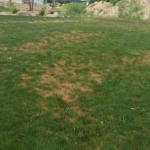Fungus: Ascochyta

 Symptoms: Ascochyta Leaf Blight is a disease that looks similar to a fertilizer burn, which is part of the reason that we found out about the disease. Some of our customers called us and mentioned that it appeared as if we had burned their lawns, but we looked in their history and we had not applied weed control and could not find any excess fertilizer in the affected sections of grass. We looked into the situation further and found some information on this disease, which is rare in Michigan because of the weather conditions that it requires. This disease will leave large irregular patches or streaks of turf a straw color, as well as collapsed tips of grass. Although this grass may look dead, the crowns of the grass and the lower stems are rarely killed and you can typically expect an 80 to 100% recovery within a few weeks, according to Iowa State University.
Symptoms: Ascochyta Leaf Blight is a disease that looks similar to a fertilizer burn, which is part of the reason that we found out about the disease. Some of our customers called us and mentioned that it appeared as if we had burned their lawns, but we looked in their history and we had not applied weed control and could not find any excess fertilizer in the affected sections of grass. We looked into the situation further and found some information on this disease, which is rare in Michigan because of the weather conditions that it requires. This disease will leave large irregular patches or streaks of turf a straw color, as well as collapsed tips of grass. Although this grass may look dead, the crowns of the grass and the lower stems are rarely killed and you can typically expect an 80 to 100% recovery within a few weeks, according to Iowa State University.
Grasses Susceptible: Kentucky Bluegrass is the type of grass that is the most susceptible, but tall rescue and perennial ryegrass can also see Ascochyta Leaf Blight damage occasionally.
Conditions Favoring Disease: The conditions that produce this disease are a large reason that the state of Michigan rarely sees Ascochyta Leaf Blight. It requires extreme heat and humidity, which often comes with large amounts of rain that are followed by a drought. We saw these conditions near the end of July 2016, where we had 19 days over 90 degrees and some large rainstorms.
Treatment: Ascochyta is a disease that is foliar, which means that the grass will outgrow it. We recommend mowing at the highest setting and avoiding mowing when it is wet to create ideal growing situations.
